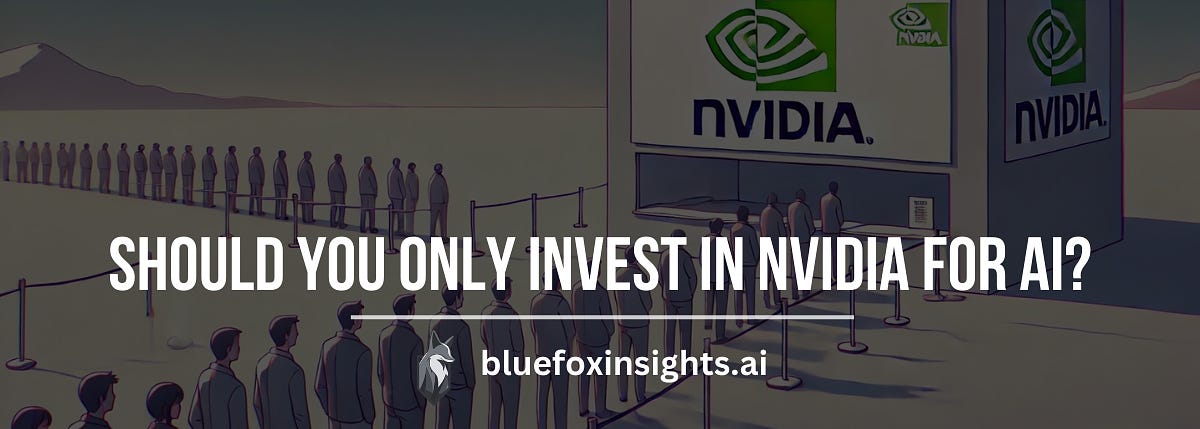Should You Invest Only in NVIDIA for AI? Understanding the Full Ecosystem Behind AI Development
Hello, my friends! It’s Dr. Joe here, and today I want to dive into a question I’ve been hearing a lot: “Should I invest only in NVIDIA for AI?” With NVIDIA’s stock shooting through the roof, thanks to its leadership in AI hardware, it's no wonder people are asking this. But here's the thing—AI isn't a one-company show. Focusing solely on NVIDIA might cause you to miss out on the broader, richer ecosystem behind AI development.
Now, let me clarify something upfront: I’m not giving financial advice. My expertise is AI, not stock markets. What I do want to share is a deeper understanding of the diverse landscape powering AI innovation. Think of it like this—building a car requires much more than just an engine. So by the end of this, I hope you’ll see why AI isn’t just about NVIDIA and why understanding the full ecosystem matters.
Engines Are LLMs (Large Language Models)
Let’s start by thinking of AI models—like large language models (LLMs)—as the engines of AI. Just like a car doesn’t move without an engine, AI applications rely on these models for their intelligence. But, just like there are different engines for different types of cars, there are also different AI engines suited for various tasks.
For example, OpenAI, Google DeepMind, and Anthropic all develop LLMs for different needs. OpenAI’s GPT models are being used in everything from chatbots to automating business operations, while Google DeepMind pushes boundaries with models like AlphaFold, which is revolutionizing scientific research. Each company creates engines tailored to specific purposes, just like how GM designs engines for different types of vehicles—some for speed, others for efficiency.
Remember, AI engines aren't just limited to OpenAI or Google. Meta AI, for instance, is building models focused on social platforms and commerce. So, just as car manufacturers make engines for different experiences, AI companies are doing the same with their models.
Cars Are AI Applications
Now, let’s move from engines to the cars themselves—this represents the AI applications you use. While the engine (the AI model) is crucial, the design, functionality, and experience of the car depend on how that engine is used. Similarly, AI applications are built around these models to solve specific problems or enhance user experiences.
Think about Tesla’s cars—focused on electric power and self-driving capabilities. In the AI world, Microsoft is doing something similar by creating applications like Copilot for Office 365 and Azure’s AI services. They’re using powerful AI engines to drive user-focused solutions, whether it’s autonomous driving or business process automation.
Other companies are on the same path. Google’s Bard, for example, is designed for creative tasks and enhanced search capabilities, while Amazon uses AI to streamline its logistics and delivery systems. Salesforce’s Einstein AI is improving customer relationship management with smarter, data-driven tools. Just like automakers design cars for different terrains, AI companies design applications for different business needs.
Factories Are Data Centers and Servers
To make these AI applications run smoothly, you need infrastructure—just like cars are assembled in factories. In the AI world, data centers and servers play the role of factories, building, running, and scaling AI applications.
Dell Technologies is a key player here. Its PowerEdge servers help businesses manage AI workloads, much like assembly lines produce cars. Similarly, Hewlett Packard Enterprise (HPE), Lenovo, and Cisco provide the backbone for AI operations, enabling companies to scale without needing to invest in massive infrastructure. And let’s not forget the cloud giants—AWS, Google Cloud, and Microsoft Azure—who offer scalable, on-demand power for companies diving into AI.
Robots Are GPUs That Train LLMs
Now, let’s get a bit more granular—onto the factory floor, where robots assemble car engines with precision and speed. In AI, GPUs (graphics processing units) serve this role. They provide the computational power to train and fine-tune AI models. Think of them as the “robots” that make the engines of AI hum with life.
NVIDIA might be the most famous name here, but it’s not the only one. AMD and Intel also produce powerful GPUs that train AI models efficiently. Companies like Graphcore and Cerebras Systems are creating AI-specific chips that may offer even faster, more efficient training methods. So, while NVIDIA leads, it's far from the only player in the game.
The Bigger Picture: AI Takes a Village
Stepping back, it’s clear that AI development is a team effort. Sure, companies like Tesla and Microsoft are creating high-end “vehicles,” but behind them are Dell, AWS, Google, and Cisco, building the factories that power these innovations. The robots—whether they come from NVIDIA, AMD, or others—are assembling the engines that make AI applications possible.
So when we talk about AI, it's crucial to recognize the diversity of players involved. NVIDIA is a leader, but AMD, Intel, Dell, HPE, AWS, and many more are equally important. Together, they’re driving AI forward, pushing the boundaries of what’s possible.
Beyond NVIDIA: Other Key Players in AI
As thrilling as NVIDIA’s stock surge may be, it’s wise to consider the broader AI landscape. Companies like AMD, Intel, Graphcore, and Cerebras Systems offer compelling alternatives in hardware. Meanwhile, Dell, HPE, and Lenovo provide the necessary infrastructure to run AI workloads efficiently. All of these companies play crucial roles in shaping the future of AI.
Conclusion: The Road Ahead
So, should you invest only in NVIDIA for AI? That’s for you to decide. What’s important to remember is that AI is a complex ecosystem, with many companies contributing to its growth. Just as building a car requires more than just an engine, AI’s progress relies on an intricate network of hardware, software, and infrastructure providers.
As AI continues to evolve, recognizing this interconnected ecosystem will help you stay ahead—whether you’re a business leader, a tech enthusiast, or even an investor. Thanks for joining me on this journey through AI’s inner workings—let’s keep learning and growing together!




